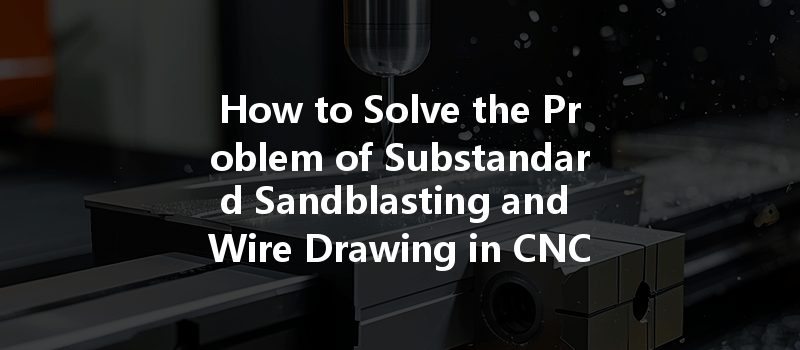Did you know that about 30% of manufacturing defects come from surface finishing, including processes like sandblasting and wire drawing? It’s a surprising statistic for many in the CNC (Computer Numerical Control) processing industry, but it highlights a significant issue: the quality of surface finishes directly impacts the product’s overall reliability and performance. As manufacturing processes become more advanced and competitive, ensuring that every stage, including surface finishing, meets high standards has never been more critical. This blog dives deep into how to tackle substandard sandblasting and wire drawing in CNC processing, providing concrete solutions and insights that can dramatically enhance the efficiency and quality of your manufacturing operations.
—
Understanding Sandblasting and Wire Drawing in CNC Processing
Before delving into solutions, it’s essential to understand what sandblasting and wire drawing entail and why they are critical in CNC processing.
What is Sandblasting?
Sandblasting, or abrasive blasting, is a process where a high-speed stream of sand or other abrasive materials is propelled against a surface. This technique is widely employed to clean, smooth, or etch materials, and it’s crucial in the preparation of surfaces for subsequent treatments (such as painting or coating).
What is Wire Drawing?
Wire drawing is a process used to reduce the diameter of a wire rod by pulling it through a series of dies. This allows the creation of wires with specific mechanical properties and dimensions. It’s a process found in various applications, including electrical components and fasteners.
Both processes serve to enhance surface finish and dimensional accuracy, making them integral to the CNC manufacturing cycle.
—
The Challenges of Substandard Sandblasting and Wire Drawing
Substandard results in sandblasting and wire drawing can arise from several factors:
To effectively address these issues, manufacturers need a comprehensive approach that spans equipment optimization, operator training, and quality control measures.
—
Solutions to Sandblasting and Wire Drawing Challenges
The foundation of the surface finishing processes is the materials used. Ensure:
Improper machine settings are often a culprit for substandard finishing. Here’s a checklist to optimize your equipment:

Even the best equipment can produce substandard results without skilled operators. Therefore:
Quality control can help catch problems early and maintain standards:
Preventative maintenance is key to sustaining quality:
—
Case Studies: Real-World Applications of Solutions
Case Study 1: A CNC Aluminum Manufacturer
A leading aluminum manufacturer faced issues with rough surface finishes due to poor sandblasting techniques. By investing in quality abrasives and retraining staff, the company improved production quality by 40% within three months.
Case Study 2: Wire Drawing Process Optimization
A custom wire manufacturer discovered that operator errors accounted for a significant amount of waste. They launched a certification program that not only improved skills but also instilled a culture of quality, resulting in a 25% reduction in waste.
—
The Role of Technology in Enhancing Finishing Processes
In today’s fast-paced manufacturing environment, technology can play a transformative role.
—
In summary, addressing substandard sandblasting and wire drawing in CNC processing requires a comprehensive approach characterized by investing in quality materials, optimizing equipment settings, enhancing operator training, implementing strict quality control measures, and maintaining equipment effectively. The constant evolution of technology further supports these solutions, paving the way for greater efficiencies.
By paying attention to these factors, manufacturers can significantly improve the quality of their products, ensuring that they meet, or even exceed, industry standards. As we navigate through increasingly demanding markets, the discussion of effective sandblasting and wire drawing techniques will remain paramount. Taking steps to refine these processes not only raises the bar for quality but also contributes to greater profitability and customer satisfaction.
Considering the crucial role that high-quality surface finishes play in product performance, manufacturers in the CNC processing landscape must prioritize the integrity of these processes. By implementing the strategies outlined in this blog, you can work towards transforming your production lines, heralding a future defined by excellence.






